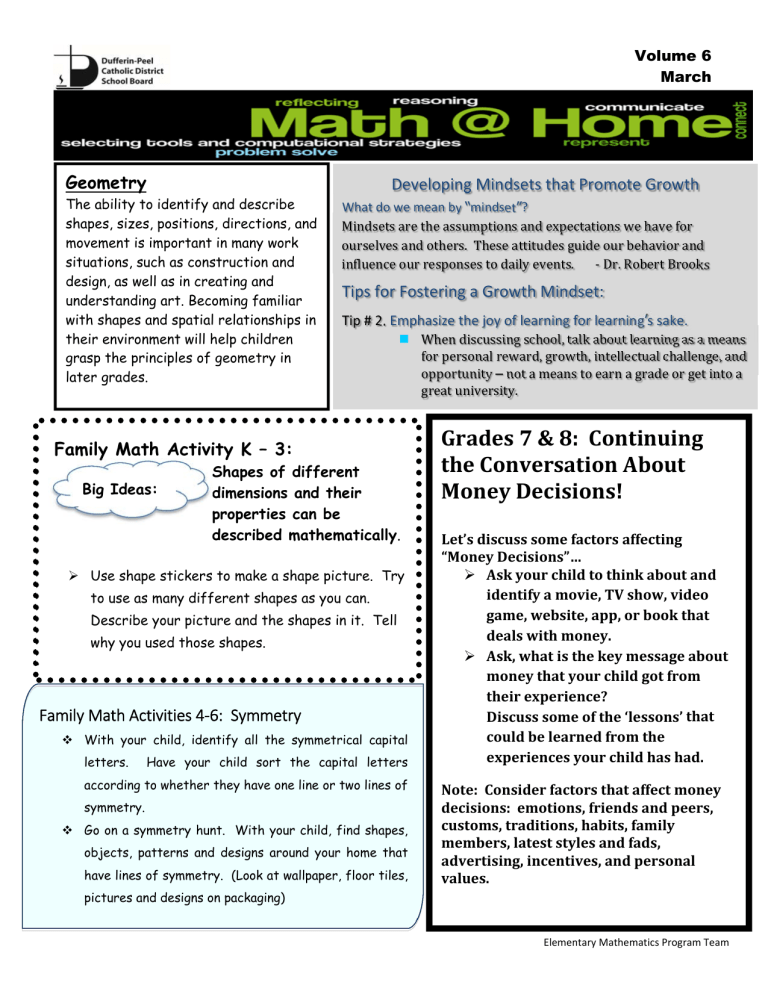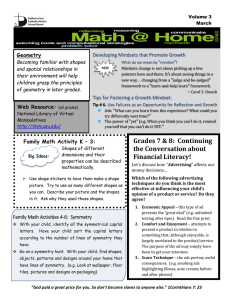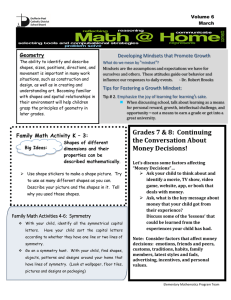Geometry Developing Mindsets that Promote Growth Volume 6

Volume 6
March
Geometry
The ability to identify and describe shapes, sizes, positions, directions, and movement is important in many work situations, such as construction and design, as well as in creating and understanding art. Becoming familiar with shapes and spatial relationships in their environment will help children grasp the principles of geometry in later grades.
What do we mean by
“ mindset
”
?
Tips
for
Developing
Fostering
a
Mindsets
Growth
that
Promote
Mindset:
Growth
Mindsets are the assumptions and expectations we have for ourselves and others. These attitudes guide our behavior and influence our responses to daily events. ‐ Dr. Robert Brooks
Tip # 2.
Emphasize the joy of learning for learning ’ s sake.
When discussing school, talk about learning as a means for personal reward, growth, intellectual challenge, and opportunity – not a means to earn a grade or get into a great university.
Family Math Activity K – 3:
Big Ideas:
Shapes of different dimensions and their properties can be described mathematically .
Use shape stickers to make a shape picture. Try to use as many different shapes as you can.
Describe your picture and the shapes in it. Tell why you used those shapes.
Family Math Activities 4 ‐ 6: Symmetry
With your child, identify all the symmetrical capital letters. Have your child sort the capital letters according to whether they have one line or two lines of symmetry.
Go on a symmetry hunt. With your child, find shapes, objects, patterns and designs around your home that have lines of symmetry. (Look at wallpaper, floor tiles, pictures and designs on packaging)
Grades 7 & 8: Continuing the Conversation About
Money Decisions!
Let’s discuss some factors affecting
“Money Decisions”…
Ask your child to think about and identify a movie, TV show, video game, website, app, or book that deals with money.
Ask, what is the key message about money that your child got from their experience?
Discuss some of the ‘lessons’ that could be learned from the experiences your child has had.
Note: Consider factors that affect money decisions: emotions, friends and peers, customs, traditions, habits, family members, latest styles and fads, advertising, incentives, and personal values.
Elementary Mathematics Program Team
Volume 7
April
Fractions
Learning about fractions extends childrens’ understanding of our number system. While whole numbers represent quantities of whole units, fractions signify parts of whole units or parts of sets. Although fractions are all around us, learning about fractions is difficult for some children. Identifying fractions in our environments makes them meaningful and easier to visualize.
Family Math Activity K – 3:
Developing Mindsets that Promote Growth
What do we mean by
“ mindset
”
?
Mindsets are the assumptions and expectations we have for ourselves and others. These attitudes guide our behavior and influence our responses to daily events. - Dr. Robert Brooks
Tips for Fostering a Growth Mindset:
Tip # 3. Set appropriately high expectations and provide support.
Expectations should focus on habits, effort, and growth, not grades.
Provide your child with other supports (extra help, additional resources). Don ’ t assume that “ you could do it easily if you just tried harder.
” relationship between a part and a whole.
With your child, gather several similarly shaped objects, such as a piece of paper, a towel, a placemat, a picture frame, a magazine and a book.
Ask your child to show you one half of each object, perhaps by using a ruler to mark the halfway point. This is an opportunity for your child to see that fractional portions must be of equal size.
Extension: Ask your child to show you one fourth of each object.
Family Math Activity 4-6:
Big Idea: Numbers tell us how much or how many
Ask what real-life situations might these fractions describe:
Two fifths 2/5
Three sixths 3/6
Five eighths 5/8
For example: Five eggs have been eaten from the dozen. This represents 5/12 of the set. Can your child describe the fraction of eggs eaten (5/12) and the remaining eggs (7/12)?
Grades 7 & 8: Continuing the Conversation About
Your Money Decisions!
Let’s discuss some factors affecting “Money
Decisions”…
Ask your child to keep a log for one week of all the times, instances, or circumstances that he/she has an encounter with money (e.g., a subway ride, buying gum at a store, going to the bank or ATM, buying an app).
Ask your child to make a list of all the ways in which money enters into his/her daily life.
Discuss with your child his/her money encounters (e.g., what was the total value of your money encounters?)
Note: Consider factors that affect money decisions: emotions, friends and peers, customs, traditions, habits, family members, latest styles and fads, advertising, incentives, and personal values.
Elementary Mathematics Program Team








